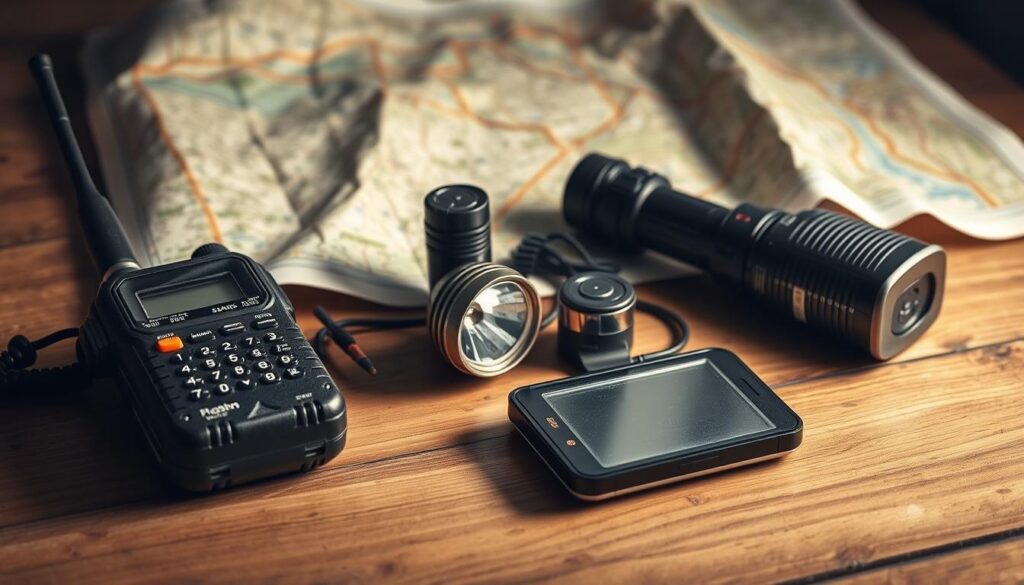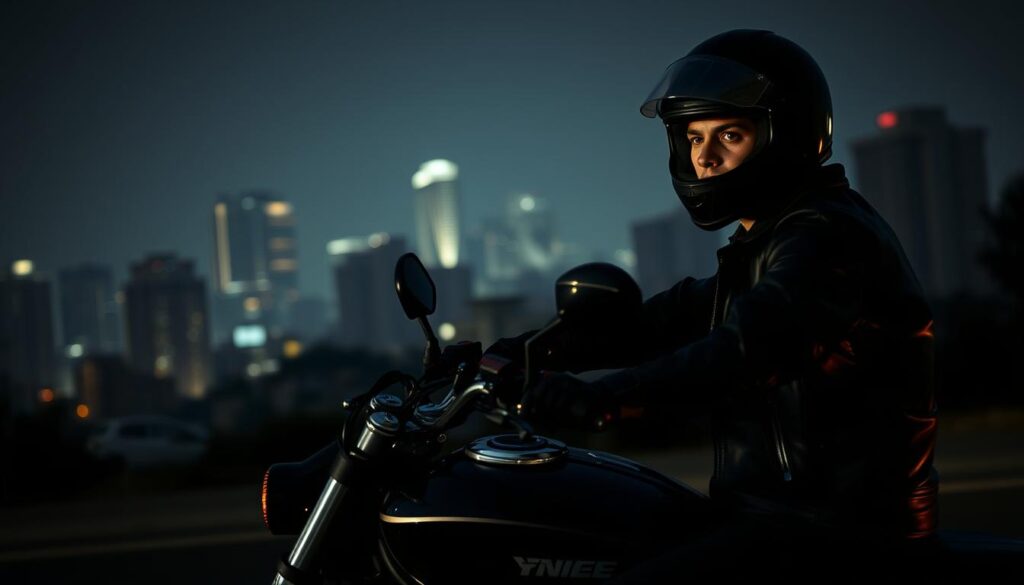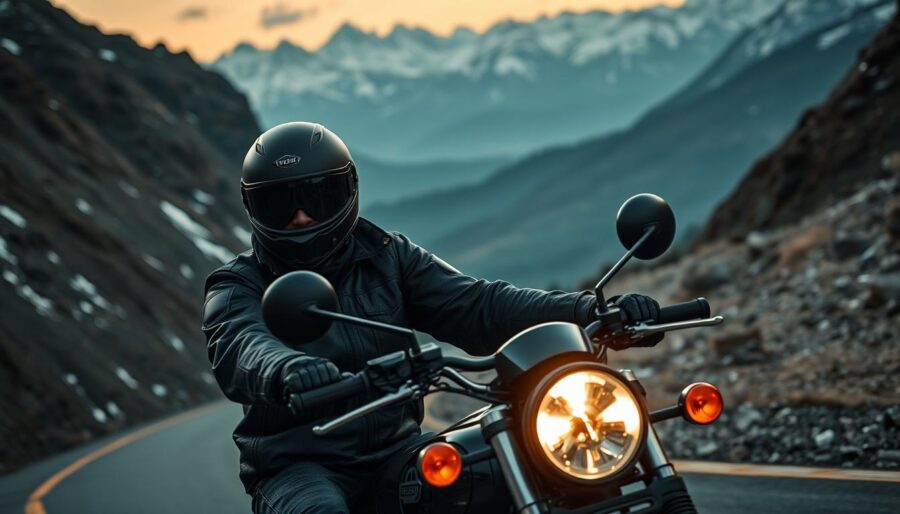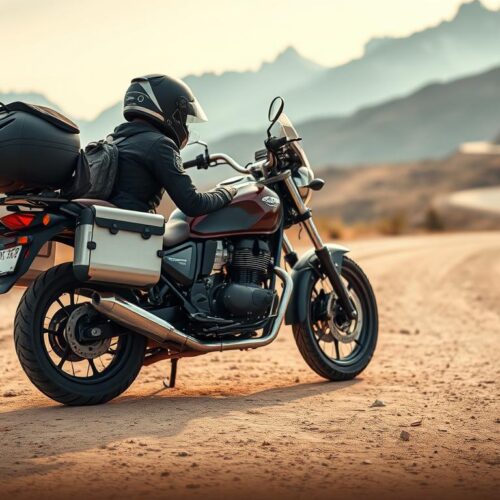Are you planning a solo motorcycle trip? This guide offers practical tips to help you stay safe. You’ll learn how to reduce risks and feel more confident while traveling alone by motorcycle in the U.S. and abroad.
Solo motorcycle travel is becoming more popular. Riders share their experiences online, inspiring others. This includes many women who choose solo rides for freedom and self-discovery. As more people ride alone, safety tips are more crucial than ever.
Riding solo offers both benefits and challenges. You get independence and the chance to learn new things. But you also have to take care of your route, gear, and reactions. This guide shares real-world tips from seasoned riders and long-term reporting.
You’ll find useful advice on staying safe while traveling solo by motorcycle. Follow these tips to plan better, avoid threats, and ride with confidence every mile.
Preparing for Your Solo Motorcycle Trip
Plan your route and book lodging in advance. Choose a main hotel and a backup close by. This way, you won’t be stuck without a place to stay after dark.
Make sure to confirm addresses and have offline directions ready. This helps you avoid getting lost and boosts your safety while traveling alone.
Make a motorcycle safety checklist. Include a basic tool kit, tire repair kit, extra fuses, and a headlamp. Also, pack a high-visibility vest and an extra light for bad weather. These items help you stay safe on the road and fix problems quickly.
Wear defensive gear that’s legal in your area. Consider carrying pepper spray, a personal alarm, or a knife. If you plan to carry a gun, check the laws in each state and get proper training.
Keep important documents safe and have backups. Carry physical copies of your ID and scan them to cloud storage or your phone. Also, have a fake wallet with some cash and expired cards in a different pocket for emergencies.
Choose safe places to stay. Opt for managed campgrounds or family-run motels instead of isolated spots. Pick hotels in well-lit areas and try to arrive during daylight.
Set daily limits and goals. Decide how far you’ll ride each day and add extra time for unexpected delays. Having a plan helps you stay calm and ensures your safety on long trips.
Start with a solid plan for your trip. Share your itinerary with someone you trust, check in regularly, and keep emergency numbers handy. These steps help make your solo ride safe and enjoyable.
Understanding the Risks of Solo Riding
When you ride alone, traffic accidents are the biggest danger. Bad road surfaces, potholes, and loose gravel can throw you off balance quickly. Big rigs and pickup trucks often can’t see you well, so stay in your lane to stay safe.
Night riding makes it harder to see and react. Try to travel during the day if you can. If you must ride at night, slow down and keep a safe distance from the car in front of you.
Urban areas have their own dangers. Some city neighborhoods are hotspots for crime and theft. Stay out of these areas, don’t show off your valuables, and choose busy, well-lit places for breaks.
Breakdowns in remote areas can be scary. You might have to wait a long time, deal with corrupt officials, or attract unwanted attention. Carry tools, spare parts, and a phone with emergency numbers. Also, have a plan for alternative routes to avoid being stuck in one place for too long.
Being predictable can make you a target. Don’t always stop at the same places at the same times. Mix up your stops, rest breaks, and where you refuel to keep others guessing. This approach helps you stay safe while traveling alone.
Stay alert and aware of your surroundings. Look out for hazards, watch how other drivers behave, and notice any signs of trouble. By being careful, planning well, wearing the right gear, and making smart choices, you can lower the risks of solo riding and enjoy your journey.
Keeping Your Personal Information Secure
When you travel alone, protect your personal data from the start to the end. Don’t share your live location on social media. Wait to post photos or your itinerary until you leave a place. This simple step helps keep your solo trip safe and less likely to be tracked.
Keep encrypted digital copies of important documents like your passport and license. Store them on a cloud or encrypted USB. Carry physical copies in separate bags and a locked case on your bike. This is especially useful for Honda, Yamaha, or Harley riders. Keep one copy in the tank bag and another in a saddlebag to make recovery easier if they get lost.
Be vague when locals ask where you’re staying. Say you have friends nearby or are in a general area. Avoid sharing the exact hotel or campsite in public. This helps you stay safe in crowded places and at checkpoints.
Get cash at banks, malls, or well-lit ATMs instead of street machines. Carry money in a waist pack, jacket pocket, and a hidden pouch. A low-value “sacrificial” wallet can protect your main money during robberies. These steps help keep your finances safe while traveling alone.
Stay calm and polite during corrupt stops or demands for extra fees. Show photocopies of your documents while keeping originals safe. Have a short, consistent story ready about your trip. This can help defuse tension and quickly get your belongings back, improving your safety on the road.
Use strong, unique passwords and two-factor authentication for all important accounts. Log out of public Wi-Fi and use a trusted VPN when accessing sensitive information. These digital habits protect your personal data and reduce the risk of identity theft while you’re on the move.
| Risk | Practical Step | Why It Helps |
|---|---|---|
| Live social posts | Delay sharing photos and locations | Prevents real-time tracking and theft |
| Lost documents | Encrypted cloud copies + layered paper copies | Simplifies replacement and proof of ID |
| Pickpocketing or robbery | Distribute cash and use a sacrificial wallet | Makes a theft less damaging to your trip |
| Corrupt checkpoints | Carry copies, stay calm, use a simple story | Reduces escalation and speeds release of items |
| Account compromise | Strong passwords, 2FA, VPN on public Wi‑Fi | Protects financial accounts and bookings |
Securing Your Motorcycle
Park in places with lots of people and good lighting. Avoid leaving your bike alone at night. Try to get to hotels or campsites before it gets dark. This way, you can pick a safe spot that helps keep you secure.
Always carry a small tool kit, tire repair kit, and a basic pump. Learn how to change a tire and fix a puncture at home. This way, you can handle problems on the road quickly. Regular checks of brakes, chain, lights, and tire pressure also help avoid breakdowns.
Use more than one way to protect your bike from theft. A strong chain or anchor, a disc lock, and a heavy-duty cable make it harder for thieves. Adding a GPS tracker or a Garmin inReach can help find your bike if it’s stolen. These steps help prevent theft and give you peace of mind.
Be careful with how you dress and arrange your gear. Keep expensive items like cameras and accessories hidden when you leave your bike. Store your luggage in a locked room or hide valuables in your panniers. This way, you don’t attract unwanted attention.
Always follow simple safety habits when stopping. Lock the steering, secure the ignition, and use a cable through the frame if you can. Take photos of your bike’s location and nearby landmarks. This helps you spot if something is off when you return.
Before you ride, check your tires and brakes, test your lights and signals, tighten everything, and make sure your luggage is secure. Doing this daily helps prevent small issues from becoming big problems. It ensures your bike is ready for the road.
| Risk | Action | Recommended Item |
|---|---|---|
| Bike theft | Anchor to fixed object and use multiple locks | Hardened chain, disc lock |
| Being stranded | Carry repair tools and practice fixes | Tire plug kit, multi-tool, pump |
| Unseen tampering | Park in well-lit, populated areas and document location | Phone camera, GPS tracker like Garmin inReach |
| Attracting thieves | Hide valuables and secure luggage | Lockable panniers, soft luggage covers |
| Mechanical failure | Do daily pre-ride checks and service on schedule | Service manual, checklist |
Navigating Your Route Safely
Before you hit the road, do some research. Look at rider reports, travel blogs, and forums. They can tell you about gas stops, scenic views, and dangers.
Carry different tools for navigation. A paper map and compass are good backups to your phone and GPS. Phones can run out of battery or have issues. Having extra tools keeps you safe.
In cities, stick to main roads. Avoid dangerous areas. If you get lost, stay calm and find your way back to safe roads.
Plan to ride during the day. Map out your route so you don’t end up riding at night. Daytime riding is safer and easier.
Be flexible with your plans. Know other places to stay and routes to take. Watch the weather and local news. Being flexible helps keep you safe.
Here’s a simple checklist for getting ready:
- Check fuel stops and how far they are.
- Download maps and save them offline.
- Bring a printed map and compass.
- Find safe places to stay overnight.
- Tell someone you trust about your plans.
Always have your route visible on your tools. Regularly check your path to avoid getting lost. These steps make solo riding safer and more enjoyable.
Communicating with Others

Before you leave, tell a trusted friend or family member where you’re going. Share your daily plans and stops. This helps them know where you are and act if you’re late.
Bring communication tools like a Garmin inReach Mini or a Sena Bluetooth communicator. These let you send messages and SOS signals. Visible gear on your bike and helmet helps in emergencies.
Make regular check-ins, not random calls. Choose times that fit your journey. Automated messages keep your contacts updated without distracting you.
Ask locals about safe places when you stop. Gas station workers and hotel staff can guide you. Their advice is key to avoiding trouble.
Act confident when you’re out. Walk fast, keep your gear visible, and don’t wear headphones. This makes you less likely to be targeted.
Use a helmet camera like the Sena 10C Pro. It deters trouble and records your ride. Remember, use the footage wisely and keep it private.
Carry a GPS tracker and share its link with two people. Choose contacts who can call for help if needed. Good communication and tools are crucial for solo riders.
Understanding Your Surroundings
When you ride, try to keep a low profile. Avoid wearing flashy jewelry or branded gear. Also, don’t leave expensive electronics where they can be seen. This helps keep you safe while traveling alone.
Always scan your surroundings, whether it’s crowds, sidewalks, or parking lots. Look for anyone who seems suspicious or keeps looking at you. Being aware of your surroundings helps you stay safe before trouble starts.
Try to arrive at your lodging and secure parking during the day if you can. Using extra bike lights and reflective gear makes you more visible. This helps you spot hazards sooner and stay safe.
It’s important to dress and act like the locals. Wearing modest clothes and being polite can help you avoid unwanted attention. This is especially true in places you don’t know well.
Listen to your instincts. If a place or situation feels wrong, trust your gut and leave. Your instincts are a quick way to judge risks and keep you safe.
Here’s a quick checklist to keep in your tank bag. Use it before stopping, parking, or talking to strangers. It helps you stay aware and secure while traveling alone.
| Before You Stop | What to Check | Action |
|---|---|---|
| Parking | Lighting, sight lines, nearby people | Choose well-lit spots with clear exits; lock bike and remove valuables |
| Taking Photos | Surroundings, escape route, local customs | Pick a safe angle, keep helmet nearby, avoid restricted areas |
| Stopping for Breaks | Traffic behavior, groups, shop owners | Park where staff can see you; avoid isolated spots |
| Interacting with Locals | Body language, tone, personal space | Stay brief, keep personal info private, meet in public areas |
| Night Riding | Visibility, road hazards, GPS signal | Use extra lights, reduce speed, stick to main roads |
Emergency Preparedness
Make a basic breakdown kit for common faults. Include a tire repair kit, spare fuses, tools, and extra fluids. Learn to fix a dead battery, loose chain, or flat tire. Also, keep a list of mechanics in the areas you’ll visit.
Carry a small first-aid kit and any personal meds. Practice using the kit’s items so you act fast when needed. Consider a GPS tracker or Garmin inReach for SOS signals when cell service is out.
Plan for being stranded. Note nearby towns and places to stay on your route. Keep emergency cash on you and know local towing and transport options. Decide if you’ll walk for help or wait for a tow.
Think about training for solo rider security. Basic self-defense classes boost your confidence when riding alone. If you carry a legal firearm, get certified training and follow state laws. Keep defensive items in easy-to-reach spots on your bike or gear.
Organize your documents to protect them from loss or theft. Carry insurance proof, motorcycle registration, and an emergency contact sheet. Store digital backups in encrypted cloud storage and on your phone. Share your emergency plan with a trusted contact who can check on you.
Follow these steps to improve motorcycle travel solo security. Small habits before every ride increase your safety and reduce risks. Keep a checklist of travel alone tips with your kit so you never forget essential items.
Dealing with Unfamiliar Situations

When someone approaches, stand steady and confident. Your body language should show you can handle yourself without starting a fight. This “Wonder Woman suit” posture helps you avoid confrontations and makes you less likely to be targeted.
Always have a way to leave quickly. Park your motorcycle where you can easily get to it. Avoid being cornered or distracted by your phone. Knowing how to leave fast is key for your safety when traveling alone.
Use smart tricks to protect against theft. Carry a fake wallet and split your cash and cards between safe pockets and luggage. This way, you can limit losses and stay safe from thieves or aggressive requests.
If police ask for bribes or press you, stay calm and polite. Show them your documents and know how to contact the U.S. embassy or consulate if you’re abroad. Clear, measured responses can help calm down tense situations.
At night and in crowded places, don’t walk alone in unsafe areas. Use official taxis or ride services from well-lit, public spots like airport taxi desks or hotel lobbies. These tips help keep you safe when you’re away from your bike.
Practice saying “No thanks” and have backup plans for tense situations. A firm “No thanks” and moving towards people can help. Training your voice and stance ahead of time boosts your confidence in handling confrontations.
Keep emergency contacts, insurance details, and a basic legal rights note in your phone and on paper. These steps help you respond fast under stress and add to your solo rider security.
Using Technology for Safety
Simple tech can keep you safe on the road. Use a GPS tracker like the Garmin inReach Mini for messaging and emergency signals. Set up scheduled check-ins so someone knows where you are.
Have backup navigation too. Smartphone maps can fail. Keep paper maps and a compass in your tank bag. A charged power bank and offline maps help avoid getting lost.
A helmet camera like the Sena 10C Pro or GoPro is useful. It records incidents and deters bad actors. Store footage on a card and back it up at night.
Keep your phone charged and have an offline contact list. Use automated location sharing for remote areas. Add a GPS tracker to your luggage to track it if stolen.
Be careful with social media. Avoid live posts that show your location. Delay sharing images and check-ins until you leave an area.
Invest in tech accessories and guides. For tips on items and mounting, see this guide: motorcycle travel accessories guide.
Technology is a safety layer, not a crutch. With a GPS tracker, helmet camera, backup navigation, and clear communication, you’ll ride safer and more confidently.
Mental Preparedness for Solo Riding
Riding alone is more than just handling skills. It’s about facing discomfort and growing from it. Knowing what to expect emotionally helps you stay calm, even when the road or weather changes.
Fear is normal and can make you more alert. It helps you avoid mistakes that could put you in danger. By turning anxiety into action plans, you make better choices.
Being self-reliant is good, but don’t be reckless. Independence is powerful, but being too bold can undo your careful planning. Know when to stop, call a friend, or join a group.
Trust your instincts. They come from experience and paying attention to details. If something doesn’t feel right, change your plans or leave early to stay safe.
Find things that calm you down. Short mindfulness exercises, a quick prayer, or steady breathing can help. These practices help you make decisions and stay calm on long rides.
Use practical tips for solo travel: set realistic daily goals, take breaks, and share your plans with someone. These steps help your mind and keep you safe.
| Mindset Skill | Action | Benefit |
|---|---|---|
| Accepting discomfort | Plan varied rides and short solo practice trips | Builds confidence without overreach |
| Managing fear | Use checklists and pre-ride routines | Channels fear into safer choices for motorcycle safety |
| Self-reliance | Carry backup contacts and emergency tools | Maintains independence while lowering risk |
| Intuition | Log lessons from each ride and review decisions | Sharpens judgment for future solo travel security |
| Personal anchors | Practice short mindfulness or breathing exercises | Improves focus and reduces road stress |
Post-Trip Safety Measures

When your ride ends, take a calm moment to review. Note any incidents, near-misses, and hazards you faced. Record the details, like times, locations, and actions taken. This helps make future rides safer.
Check your gear and devices. Make sure cameras, phones, and GPS are there and working. Back up your photos and documents online to keep your data safe.
Don’t wait to address health and legal matters. See a doctor for any injuries. Report thefts or crimes to the police and your insurance. Also, tell your bank about any strange charges.
Share what you learned with other riders. Write a review on forums or blogs about your trip. Your honest feedback can help others stay safe on the road.
Before your next ride, restock and renew your supplies. Replace old tires, refill first-aid kits, and update your tools. Take training in mechanics, self-defense, and legal basics to stay safe.
| Action | Why It Matters | When to Do It |
|---|---|---|
| Document incidents and near-misses | Creates a factual record for learning and insurance | Within 24–48 hours of trip end |
| Inventory gear and back up data | Prevents loss of evidence and personal memories | Day after arrival |
| Medical check and legal reports | Protects health and preserves claims | Immediately for injuries; within 72 hours for reports |
| Share lessons on forums | Improves community knowledge of hazards | Within one week of trip |
| Replace consumables and train | Makes your next solo ride safer and more reliable | Before the next trip |
Conclusion: Riding Wisely and Safely Alone
You can make motorcycle travel solo security part of every ride by planning ahead and using proven habits. Prebook lodging when it helps, pack repair and first-aid gear, and carry both a GPS device and a paper map. These steps lower risk and keep your trip smooth.
Practice solo rider security by varying navigation and communication tools. Use a GPS tracker or helmet camera, keep your phone charged, and share your route with a trusted contact. Secure your motorcycle with a lock and alarm, protect personal data, and avoid risky neighborhoods to strengthen your solo travel security.
Develop motorcycle safety skills and situational awareness so you can respond to changing road or social conditions. Travel by day when possible, trust your instincts, and rehearse basic repairs. Those travel alone tips—planning, redundancy, and training—make riding alone more rewarding and far safer.
With preparation, adaptable planning, and practical measures used by experienced riders, you’ll reduce risk and increase enjoyment. Ride confidently, keep learning, and make every solo journey a memorable one.




